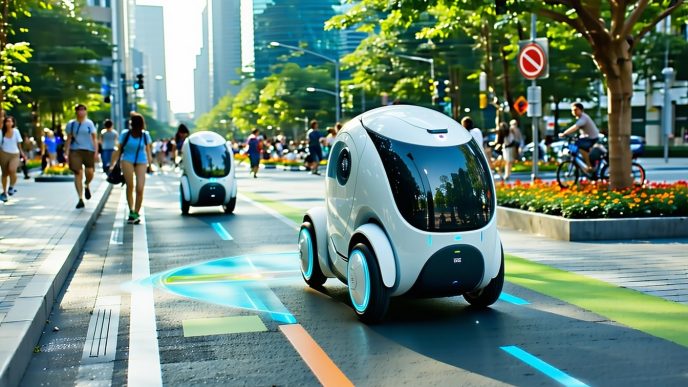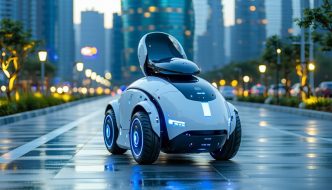Understanding Battery Range for Rideable Robots
Importance of Battery Range in Rideable Robots
Battery range is a critical factor in the usability and efficiency of rideable robots. For urban commuters and tech enthusiasts, the ability to travel a reasonable distance on a single charge makes these devices practical for daily transportation. The battery range directly affects the convenience of using these robots for tasks such as commuting to work, running errands, or enjoying recreational rides. A longer battery range ensures flexibility and reduces anxiety about finding charging stations, particularly in urban environments where infrastructure may vary.
The importance of battery range extends beyond practicality; it influences user satisfaction and the overall adoption of rideable technology. As more individuals consider robot-enhanced transport devices for their mobility solutions, manufacturers are pushed to innovate and enhance battery performance. For more on how these devices fit into broader trends, visit our section on transportation and rideability robots.
Factors Affecting Battery Range
Several variables affect the battery range of rideable robots. Understanding these factors helps users make informed choices about their transportation devices.
| Factor | Description |
|---|---|
| Battery Capacity | Measured in amp-hours (Ah), higher capacity batteries can store more energy, providing longer range. |
| Weight of the Rider | Heavier riders require more energy to travel, impacting the overall distance achievable on a single charge. |
| Terrain | Different terrains demand varying power levels; steep inclines or rough surfaces can reduce battery life. |
| Speed | Higher speeds lead to increased energy consumption, lowering the overall range available. |
| Weather Conditions | Wind resistance and temperature affect battery performance; cold weather can reduce range significantly. |
| Motor Efficiency | Advanced motors that optimize energy use can extend battery range by using less power for similar performance. |
Understanding these influencing factors empowers potential users to choose the right rideable device based on their specific needs. Those interested in shorter trips may find specialized options as effective solutions, as discussed in our article on rideable robots for short trips.
By considering battery range along with the multitude of factors affecting it, users can enjoy a more seamless experience in their robot-enhanced transportation journeys.
Types of Rideable Robots
Rideable robots are revolutionizing personal mobility, offering innovative solutions for urban transportation. This section explores three popular types of rideable robots: electric scooters, electric skateboards, and electric unicycles, focusing on their features and battery range capabilities.
Electric Scooters
Electric scooters have gained immense popularity as a convenient mode of transportation in urban environments. Equipped with a rechargeable battery, these scooters typically range between 15 to 40 miles on a single charge, depending on various factors.
| Range (miles) | Average Speed (mph) | Weight Limit (lbs) |
|---|---|---|
| 15 – 40 | 15 – 25 | 220 – 300 |
Electric scooters are user-friendly and can be easily folded for portability. Their battery capacity is a critical factor in determining the overall range, making them suitable for short to medium-distance commutes.
For more information on rideable robots for short trips, explore our article on rideable robots for short trips.
Electric Skateboards
Electric skateboards present an alternative form of rideable robots that appeal to a more adventurous user base. With board lengths and designs varying significantly, these devices typically offer a battery range of 10 to 30 miles per charge.
| Range (miles) | Average Speed (mph) | Weight Limit (lbs) |
|---|---|---|
| 10 – 30 | 10 – 20 | 250 – 300 |
Electric skateboards provide riders with a sense of freedom and flexibility while facilitating easier maneuverability in crowded areas. Like electric scooters, factors such as battery voltage and energy efficiency play a crucial role in their performance.
Electric Unicycles
Electric unicycles are an intriguing option for those seeking a unique rideable experience. These personal transport devices feature a single wheel and require balance and skill to operate. The battery range for electric unicycles tends to be between 15 to 50 miles on a full charge.
| Range (miles) | Average Speed (mph) | Weight Limit (lbs) |
|---|---|---|
| 15 – 50 | 12 – 25 | 220 – 300 |
Electric unicycles offer considerable agility and can weave through traffic effectively. They are often favored by those wanting to add a level of excitement to their daily commutes.
In summary, understanding the various types of rideable robots, such as electric scooters, electric skateboards, and electric unicycles, is essential for users considering their battery range and suitability for their travel needs. For more insights into the future of these innovative devices, explore our article on future of rideable robotics.
Calculating Battery Range
Understanding the battery range is essential for users of rideable robots. Several key factors contribute to determining how far these devices can travel on a single charge: battery capacity and voltage, as well as energy efficiency.
Battery Capacity and Voltage
Battery capacity, measured in amp-hours (Ah), indicates the total amount of energy a battery can store. Higher capacity batteries provide longer ride times before needing a recharge. Voltage, measured in volts (V), determines how much power is supplied to the motor, influencing performance and top speed.
The relationship between capacity and voltage is represented in the following table:
| Battery Type | Capacity (Ah) | Voltage (V) | Total Energy (Wh) |
|---|---|---|---|
| Lithium-ion | 5 | 36 | 180 |
| Lithium-ion | 10 | 48 | 480 |
| Lead-acid | 12 | 24 | 288 |
Total energy (Wh) is calculated by multiplying the capacity (Ah) by the voltage (V). A higher total energy allows for greater potential distance traveled. However, the design and efficiency of the rideable robot also play significant roles in actual battery range.
Energy Efficiency of Rideable Robots
Energy efficiency measures how effectively a rideable robot converts electrical energy from the battery into distance traveled. Factors influencing energy efficiency include the motor type, weight of the device, rider weight, terrain, and riding style.
Typically, the energy efficiency of rideable robots can be seen in the following table, which shows distance traveled per kilowatt-hour (kWh) under optimal conditions:
| Type of Rideable Robot | Distance per kWh (miles) |
|---|---|
| Electric Scooter | 30 |
| Electric Skateboard | 15 |
| Electric Unicycle | 20 |
This data indicates that electric scooters generally offer the best distance per energy unit, making them a suitable option for urban commuters interested in maximizing their travel distance without frequent recharges.
Readers interested in exploring more about rideable robots can check out articles on specific use cases, such as transportation and rideability robots and rideable robots for short trips. Understanding battery range and efficiency provides valuable insight for potential owners looking to make informed choices about their rideable technology.
Real-World Examples
Understanding the practical applications of battery range for rideable robots can enhance the decision-making process for users who are interested in these innovative transportation solutions. This section examines a range comparison of popular rideable devices followed by case studies that highlight long-distance travel.
Range Comparison of Popular Rideable Robots
Different rideable robots offer varying battery ranges, which can be influenced by their design, weight, and energy efficiency. Below is a comparison table that outlines the estimated range for some common types of rideable robots.
| Type of Rideable Robot | Estimated Battery Range (miles) |
|---|---|
| Electric Scooter | 15 – 40 |
| Electric Skateboard | 7 – 20 |
| Electric Unicycle | 10 – 30 |
These estimates show that electric scooters generally provide the most extensive range, making them suitable for longer commutes. Electric skateboards and unicycles are more suitable for shorter trips or specific uses. For information about rideable robots tailored for brief journeys, check out our article on rideable robots for short trips.
Case Studies of Long-Distance Travels
Long-distance travel with rideable robots is becoming more common, thanks to advancements in battery technology. The following case studies demonstrate how individuals have successfully utilized these robots for extensive trips.
-
City Commute: An urban commuter utilized an electric scooter for a round trip of 30 miles daily through a metropolitan area. The scooter’s battery capacity allowed for two trips without needing a recharge during the day. Travel times were reduced compared to traditional public transportation options, showcasing the effectiveness of robot transportation vs traditional options.
-
Touring Adventure: An enthusiast used an electric unicycle to travel 25 miles through scenic routes over a weekend. With proper planning and understanding of charging stations along the way, the user could effortlessly complete the journey while enjoying the landscapes.
-
Event Participation: A group of tech enthusiasts participated in an event, using electric skateboards to cover a distance of 15 miles from their accommodation to the venue. They were able to maximize battery use by practicing efficient riding techniques.
These real-world examples highlight the practical advantages of incorporating rideable robots into daily life and emphasize their potential for longer journeys. For insights on ensuring stability and safety during travel, consider reading about rideable robot stability and safety.
Tips to Maximize Battery Range
Maximizing the battery range for rideable robots is essential for efficient and enjoyable travel. Here are several tips that can help users extend their ride time.
Proper Maintenance of Batteries
Regular maintenance of batteries plays a crucial role in ensuring they function optimally. Proper care can prolong the lifespan of batteries and help maintain their efficiency. Key maintenance tips include:
- Regular Charging: It’s important to follow the manufacturer’s guidelines for charging intervals. Overcharging or letting the battery deplete completely can reduce overall capacity.
- Cleaning Contacts: Keeping the battery contacts clean helps ensure a good connection and improves performance.
- Temperature Management: Batteries should be stored and used within the recommended temperature ranges. Extreme temperatures can significantly affect battery performance.
| Battery Condition | Impact on Performance |
|---|---|
| Well-Maintained | Optimal range and efficiency |
| Overcharged | Reduced lifespan and capacity |
| Dirty Contacts | Poor connectivity and performance |
| Extreme Temperatures | Decreased efficiency |
Efficient Riding Techniques
Riding techniques can also influence battery life. Using efficient methods while riding rideable robots can extend travel distances. Consider the following strategies:
- Smooth Acceleration: Gradual acceleration reduces the energy drawn from the battery, enhancing battery life.
- Avoiding Sudden Stops and Starts: Maintaining a consistent speed conserves energy and maximizes range.
- Using Regenerative Braking: If available, utilizing regenerative braking can help recover some energy while slowing down.
| Riding Technique | Benefits |
|---|---|
| Smooth Acceleration | Decreased energy consumption |
| Consistent Speed | Improved overall range |
| Regenerative Braking | Energy recovery for longer rides |
Charging Strategies
Implementing effective charging strategies can significantly impact the battery range for rideable robots. Strategic charging not only influences current performance but also the longevity of the battery. Some recommended strategies are:
- Charging Before Long Trips: Fully charging before embarking on longer journeys ensures maximum range.
- Avoiding Fast Charging: While quick charging is convenient, it may affect battery health over time. Opt for standard charging when possible.
- Using Smart Chargers: Smart chargers that detect full charge can help prevent overcharging, optimizing battery lifespan.
| Charging Method | Pros and Cons |
|---|---|
| Standard Charging | Best for battery health, longer duration |
| Fast Charging | Convenient, but may reduce lifespan |
| Smart Chargers | Prevents overcharging, maintains battery health |
By following these best practices for battery maintenance, riding techniques, and charging strategies, users can maximize the battery range of their rideable robots. For more insights on the advancements in rideable technology, visit our article on future of rideable robotics.
Future Trends in Battery Technology
As the demand for rideable robots continues to rise, advancements in battery technology play a pivotal role in enhancing battery range for rideable robots. The following sections will explore the latest developments in battery capacity and the overall impact these innovations will have on the future of mobility.
Advancements in Battery Capacity
Recent advancements in battery technologies have significantly increased the energy density, lifespan, and efficiency of batteries. Key innovations include:
-
Solid-State Batteries: These batteries replace the liquid electrolyte with solid materials, allowing for a higher energy density. This means that rideable robots can travel further on a single charge without increasing the weight of the batteries.
-
Lithium-Sulfur Batteries: This technology offers a higher capacity than traditional lithium-ion batteries and can potentially extend the range of rideable robots significantly, providing a more sustainable option with less environmental impact.
-
Fast Charging Technologies: Innovations aimed at reducing charging times enable users to recharge their devices quickly, making rideable robots more convenient for urban commuters. Fast-charging solutions can reduce downtime, allowing for more frequent use throughout the day.
The table below summarizes the potential improvements in battery capacity with these technologies:
| Battery Type | Energy Density (Wh/kg) | Benefits |
|---|---|---|
| Lithium-Ion (Traditional) | 150-200 | Widely used, decent performance |
| Solid-State | 300-500 | Higher capacity, improved safety |
| Lithium-Sulfur | 500+ | Extremely high capacity, eco-friendly options |
| Fast-Charging Lithium-Ion | Same as traditional | Reduced charging times |
Impact of Battery Innovations on Rideable Robots
The advancements in battery capacity directly affect the functionality and appeal of rideable robots in urban mobility. Key impacts include:
-
Increased Range: Longer-lasting batteries allow riders to cover greater distances on a single charge, addressing one of the primary concerns for users of electric scooters, skateboards, and other rideable robots. Users can rely on these devices for longer commutes without the anxiety of battery depletion.
-
Enhanced Performance: Higher capacity batteries enable rideable robots to operate more efficiently, even under various conditions such as inclines or heavy loads. This improvement contributes to a smoother ride and enhances user experience.
-
Accessibility Improvements: With the rise of battery-driven transport solutions, innovations such as robot mobility aids for disabled users can extend the reach of these technologies, making transportation more accessible to wider populations.
-
Environmental Benefits: As battery technology continues to evolve, rideable robots can become more eco-friendly. Options like lithium-sulfur batteries can reduce reliance on traditional power sources, aligning with growing environmental concerns.
Innovations in battery technology pave the way for a future where rideable robots transform urban mobility, blending convenience with sustainability. Understanding these advancements will enable early adopters and tech enthusiasts to make informed decisions about their modes of transportation. For more insights into the evolving landscape of transportation, see our article on the future of rideable robotics.















